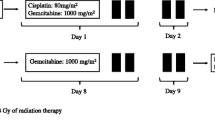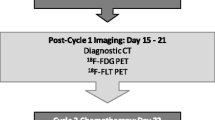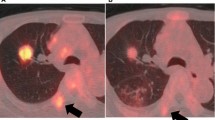Abstract
Purpose
To evaluate the predictive value of early and late residual 18F-fluorodeoxyglucose (FDG) and 18F-fluorothymidine (FLT) uptake using different SUV measurements in PET in patients with advanced non-small-cell lung cancer (NSCLC) treated with erlotinib.
Methods
We retrospectively reviewed data from 30 patients with untreated stage IV NSCLC who had undergone a combined FDG PET and FLT PET scan at 1 week (early) and 6 weeks (late) after the start of erlotinib treatment. Early and late residual FDG and FLT uptake were measured in up to five lesions per scan with different quantitative standardized uptake values (SUVmax, SUV2Dpeak, SUV3Dpeak, SUV50, SUVA50, SUVA41) and compared with short-term outcome (progression vs. nonprogression after 6 weeks of erlotinib treatment). Receiver-operating characteristics (ROC) curve analysis was used to determine the optimal cut-off value for detecting nonprogression after 6 weeks. Kaplan-Meier analysis and the log-rank test were used to evaluate the association between residual uptake and progression-free survival (PFS).
Results
Nonprogression after 6 weeks was associated with a significantly lower early and late residual FDG uptake, measured with different quantitative parameters. In contrast, nonprogression after 6 weeks was not associated with early and late residual FLT uptake. Furthermore, patients with a lower early residual FDG uptake measured in terms of SUVmax and SUV2Dpeak had a significantly prolonged PFS (282 days vs. 118 days; p = 0.022) than patients with higher values. Similarly, lower late residual FDG uptake and early residual FLT uptake measured in terms of SUV3Dpeak, SUVA50 and SUVA41, and late FLT uptake measured in terms of SUV3Dpeak and SUVA50 was associated with an improved PFS.
Conclusion
Early and late residual FDG uptake, measured using different quantitative SUV parameters, are predictive factors for short-term outcome in patients with advanced NSCLC treated with erlotinib. Additionally, low residual FDG and FLT uptake early and late in the course of erlotinib treatment is associated with improved PFS.






Similar content being viewed by others
References
Prior JO, Montemurro M, Orcurto MV, Michielin O, Luthi F, Benhattar J, et al. Early prediction of response to sunitinib after imatinib failure by 18F-fluorodeoxyglucose positron emission tomography in patients with gastrointestinal stromal tumor. J Clin Oncol. 2009;27(3):439–45.
Mileshkin L, Hicks RJ, Hughes BG, Mitchell PL, Charu V, Gitlitz BJ, et al. Changes in 18F-fluorodeoxyglucose and 18F-fluorodeoxythymidine positron emission tomography imaging in patients with non-small cell lung cancer treated with erlotinib. Clin Cancer Res. 2011;17(10):3304–15.
Zander T, Scheffler M, Nogova L, Kobe C, Engel-Riedel W, Hellmich M, et al. Early prediction of nonprogression in advanced non-small-cell lung cancer treated with erlotinib by using [(18)F]fluorodeoxyglucose and [(18)F]fluorothymidine positron emission tomography. J Clin Oncol. 2011;29(13):1701–8.
Wahl RL, Jacene H, Kasamon Y, Lodge MA. From RECIST to PERCIST: evolving considerations for PET response criteria in solid tumors. J Nucl Med. 2009;50 Suppl 1:122S–50S.
Kahraman D, Scheffler M, Zander T, Nogova L, Lammertsma AA, Boellaard R. Quantitative analysis of response to treatment with erlotinib in advanced non-small cell lung cancer using 18F-FDG and 3'-deoxy-3'-18F-fluorothymidine PET. J Nucl Med. 2011;52(12):1871–7.
Akhurst T, Downey RJ, Ginsberg MS, Gonen M, Bains M, Korst R, et al. An initial experience with FDG-PET in the imaging of residual disease after induction therapy for lung cancer. Ann Thorac Surg. 2002;73:259–64.
Hoekstra CJ, Stroobants SG, Smit EF, Vansteenkiste J, van Tinteren H, Postmus PE, et al. Prognostic relevance of response evaluation using [18F]-2-fluoro-2-deoxy-D-glucose positron emission tomography in patients with locally advanced non-small-cell lung cancer. J Clin Oncol. 2005;23(33):8362–70.
Boellaard R. Need for standardization of 18F-FDG PET/CT for treatment response assessments. J Nucl Med. 2011;52 Suppl 2:93S–100S.
Boellaard R, Krak NC, Hoekstra OS, Lammertsma AA. Effects of noise, image resolution, and ROI definition on the accuracy of standard uptake values: a simulation study. J Nucl Med. 2004;45(9):1519–27.
Krak NC, Boellaard R, Hoekstra OS, Twisk JW, Hoekstra CJ, Lammertsma AA. Effects of ROI definition and reconstruction method on quantitative outcome and applicability in a response monitoring trial. Eur J Nucl Med Mol Imaging. 2005;32(3):294–301.
van Heijl M, Omloo JM, van Berge Henegouwen MI, van Lanschot JJ, Sloof GW, Boellaard R. Influence of ROI definition, partial volume correction and SUV normalization on SUV–survival correlation in oesophageal cancer. Nucl Med Commun. 2010;31(7):652–8.
Boellaard R, O'Doherty MJ, Weber WA, Mottaghy FM, Lonsdale MN, Stroobants SG, et al. FDG PET and PET/CT: EANM procedure guidelines for tumour PET imaging: version 1.0. Eur J Nucl Med Mol Imaging. 2010;37(1):181–200.
Denecke T, Hundsdorfer P, Misch D, Steffen IG, Schonberger S, Furth C, et al. Assessment of histological response of paediatric bone sarcomas using FDG PET in comparison to morphological volume measurement and standardized MRI parameters. Eur J Nucl Med Mol Imaging. 2010;37(10):1842–53.
Sohn HJ, Yang YJ, Ryu JS, Oh SJ, Im KC, Moon DH, et al. [18F]Fluorothymidine positron emission tomography before and 7 days after gefitinib treatment predicts response in patients with advanced adenocarcinoma of the lung. Clin Cancer Res. 2008;14(22):7423–9.
Buckler AJ, Boellaard R. Standardization of quantitative imaging: the time is right, and 18F-FDG PET/CT is a good place to start. J Nucl Med. 2011;52(2):171–2.
Binns DS, Pirzkall A, Yu W, Callahan J, Mileshkin L, Conti P, et al. Compliance with PET acquisition protocols for therapeutic monitoring of erlotinib therapy in an international trial for patients with non-small cell lung cancer. Eur J Nucl Med Mol Imaging. 2011;38(4):642–50.
Acknowledgments
This work was supported by funding to the Center for Integrated Oncology Cologne Bonn from German Cancer Aid as part of the Program for the Development of Interdisciplinary Oncology Centers of Excellence and by the German Federal Ministry of Science and Education (BMBF) as part of the National Genome Research Network program (NGFNplus, grants 01GS08100) to Jürgen Wolf. Matthias Scheffler was partly supported by the German Federal Ministry of Research and Education (BMBF grant 01KN0706). Erlotinib was supplied by Roche.
Author information
Authors and Affiliations
Corresponding author
Rights and permissions
About this article
Cite this article
Kobe, C., Scheffler, M., Holstein, A. et al. Predictive value of early and late residual 18F-fluorodeoxyglucose and 18F-fluorothymidine uptake using different SUV measurements in patients with non-small-cell lung cancer treated with erlotinib. Eur J Nucl Med Mol Imaging 39, 1117–1127 (2012). https://doi.org/10.1007/s00259-012-2118-8
Received:
Accepted:
Published:
Issue Date:
DOI: https://doi.org/10.1007/s00259-012-2118-8




